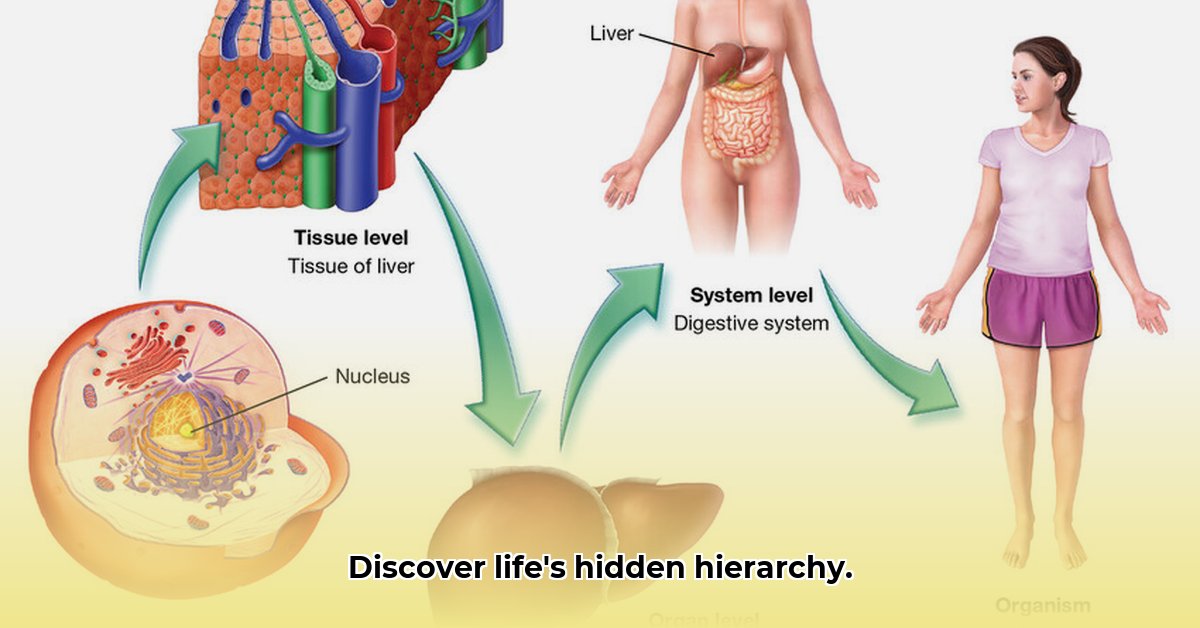Ever wonder how your body works? It’s not just a collection of random parts; it’s an incredibly organized system, similar to a complex LEGO castle. This article explores that organization, showing how cells team up to form complex organisms. We’ll go from cells to organ systems, explaining how they interact and maintaining balance. For a visual representation of the human body’s internal organization, check out this helpful resource on human anatomy.
Bodies of Organisms: A Hierarchical View
Let’s explore how living things are well-organized, with each part crucial. Starting with the smallest pieces and working our way up, we will explore the building blocks of life and their relationship to human anatomy. This hierarchical approach will illuminate the interconnectedness of biological systems.
The Amazing World of Cells: Life’s Tiny Powerhouses
Every living thing, from bacteria to giant sequoias, starts as a single cell. Cells are the basic LEGO bricks of life, each a tiny factory with specific jobs related to cellular biology. Some specialize in movement, others in sensing light, and others in generating energy. This division of labor allows complex organisms to exist, perform specialized functions, and maintain life.
Imagine a single cell, a microscopic world teeming with activity. Inside, molecules are built and broken down with incredible precision, signals are sent and received instantaneously, and energy is constantly being produced and consumed. It’s perfectly equipped to survive and reproduce and forms the basis of all life, whether it’s a single-celled organism like an amoeba or a complex creature like a human being. How does the specialization of cells contribute to the overall complexity and efficiency of an organism?
Tissues: Teamwork Makes the Dream Work
Cells group together to form tissues, like a team specializing in a specific task. In animals, there are four main tissue types, which all support organ function:
- Epithelial tissue: The body’s covering, like skin or the lining of the gut. It protects underlying tissues from damage, regulates the movement of substances in and out of the body, and acts as a dynamic barrier against infection and injury.
- Connective tissue: Supports and connects different parts of the body, like bones, tendons, ligaments, and cartilage. It provides structural support, cushions organs, and facilitates communication between different parts of the body.
- Muscle tissue: Allows movement, contraction, and relaxation for walking, breathing, and digestion. There are three types: skeletal, smooth, and cardiac, each with unique roles in maintaining bodily functions.
- Nervous tissue: The body’s communication network, sending signals throughout the body. It’s composed of neurons and glial cells, which work together to transmit electrical and chemical signals throughout the body, enabling rapid communication and coordination of bodily functions.
Plants also have specialized tissues, like xylem and phloem, transporting water and nutrients throughout the plant’s body. These vascular tissues are essential for plant survival, enabling them to transport essential resources from the roots to the leaves and vice versa.
Organs: Specialized Teams Working Together
Different tissues group together to form organs. Each organ, vital to bodily systems, has a unique job: the heart pumps blood, the lungs take in oxygen, and the liver filters toxins. These organs are complex structures made up of multiple tissue types that work together to carry out specific functions essential for life. The coordination within an organ showcases the interplay of tissue types, demonstrating the incredible complexity of biological systems.
Organ Systems: The Master Orchestra
Multiple organs work together in organ systems. For example, the circulatory system includes the heart, blood vessels, and blood, transporting oxygen and nutrients related to the blood stream. The respiratory system brings in the needed oxygen. The digestive system breaks down food, and the nervous system coordinates everything. Every system is vital for keeping the organism alive and functioning properly.
These systems coordinate their actions, creating a level of integration that is essential for maintaining life. This intricate network ensures that organs and tissues work together seamlessly to maintain the functioning of the body. This intricate network ensures that all the diverse organs and tissues work together seamlessly to maintain the functioning of the body as a whole. Consider the interaction between the digestive and endocrine systems, where hormones regulate digestion and nutrient absorption.
Maintaining Balance: Homeostasis, the Body’s Balancing Act
Our bodies constantly adjust to internal and external changes to stay stable and healthy. This balance, called homeostasis, is essential for survival and impacts overall health. Your body monitors its internal environment and makes adjustments (such as regulating temperature, blood pressure, and blood sugar levels) to maintain balance. Disruptions to homeostasis can lead to disease, highlighting the importance of maintaining this delicate equilibrium.
Plants: A Different Kind of Organization
While animals follow a linear hierarchy, plants show modularity. They have growth points called meristems that produce new modules – self-contained units like leaves, stems, and flowers, impacting plant systems. Each module functions independently but contributes to the overall plant, allowing plants to adapt and respond to changing environmental conditions. This modular organization allows plants to efficiently allocate resources and adapt to diverse environments.
The Amazing Diversity of Form and Function
Cell shape varies greatly. A nerve cell’s long shape transmits signals efficiently, while a red blood cell’s disc shape maximizes oxygen transport. This principle – form following function – is seen at all levels of biological organization and impacts the evolution of organisms. The shape and structure of each component are exquisitely adapted for their specific roles, optimizing their performance and contributing to the overall efficiency of the organism. Consider the streamlined bodies of aquatic animals, which reduce drag and allow for efficient movement through the water.
Putting it All Together: A Symphony of Life
From cells to organ systems, each level of organization is vital for living things. It showcases nature’s elegant design and the interconnectedness of life, impacting the ecological system. What new discoveries might change our understanding of life’s complex systems, shedding light on the mysteries of biology and paving the way for new medical and technological advancements?
How to Compare Metabolic Rates Across Different Sized Organisms
Key Takeaways:
- Despite huge differences in body size, many organisms show surprisingly similar mass-specific metabolic rates at rest, a phenomenon known as metabolic scaling.
- This challenges existing theories like Kleiber’s Law, which predict a wider range based solely on size, highlighting the complexity of metabolic processes.
- How to compare metabolic rates across different sized organisms requires careful standardization of measurements and consideration of factors beyond just body mass, such as activity level, temperature, and evolutionary history.
- Understanding this “metabolic homeostasis” is crucial for biology, medicine, and ecology, with implications for energy consumption, resource allocation, and ecosystem dynamics.
The Great Metabolic Mystery: Size Doesn’t Always Matter
Comparing the energy needs of a hummingbird and an elephant, you’d expect a massive difference, right? Intriguingly, studies suggest that when adjusted for body size, the resting energy expenditure – the metabolic rate – of these creatures isn’t as disparate as you might think. This convergence in mass-specific metabolic rates across species, spanning from bacteria to blue whales, is one of biology’s most intriguing puzzles, challenging our conventional concept of the food chain and energy flow in ecosystems.
Why the Puzzle? Kleiber’s Law and Its Limits
For decades, Kleiber’s Law has suggested that larger organisms have lower mass-specific metabolic rates than smaller ones, a relationship often expressed as a power law with an exponent of approximately 0.75. Recent research paints a different picture, showing a narrower range of mass-specific metabolic rates than Kleiber’s Law predicts, particularly at the extremes of body size. This has sparked a lively debate amongst biologists, creating new challenges for the application of biology and forcing scientists to re-evaluate the underlying mechanisms governing metabolic scaling.
The Challenges of Comparison: How to Compare Metabolic Rates Across Different Sized Organisms Effectively?
Directly comparing metabolic rates across species is complex, especially when factoring in environmental impact. Consider these significant challenges:
- Standardization is key: Different labs may use varying measurement techniques, units, and experimental conditions, leading to inconsistencies and difficulties in comparing data across studies.
- Physiological state matters: Metabolic rate fluctuates significantly with activity levels, temperature, reproductive status, and other physiological factors, making it essential to control or account for these variables when comparing metabolic rates across organisms.
- Environmental influence: Temperature impacts metabolism; a cold-blooded lizard will have a lower metabolic rate in the cold than a warm-blooded mammal at the same temperature, highlighting the importance of considering the thermal environment when comparing metabolic rates.
Delving Deeper: Beyond Simple Scaling
To move beyond these challenges and accurately compare metabolic rates, a multi-faceted approach is necessary. This approach can significantly impact species survival and conservation efforts. It involves:
- Standardized protocols: Develop universally accepted methods for measuring metabolic rates, including guidelines for controlling environmental factors, measuring activity levels, and reporting data in a consistent format.
- Comparative analyses: Conduct rigorous statistical comparisons across organisms, focusing on specific taxa and ecological roles, while accounting for phylogenetic relationships and evolutionary history.
- Integrative models: Develop sophisticated models that incorporate cellular-level processes, organismal-level adaptations, and environmental factors to provide a more comprehensive understanding of metabolic scaling.
- Investigating cell size: Explore the relationship between cell size, mitochondrial density, and metabolic rate to uncover the cellular basis of metabolic scaling and its implications for organismal physiology.
The Bigger Picture: Implications for Biology and Beyond
Understanding metabolic rate homeostasis has broader implications for human sustainability, resource management,










